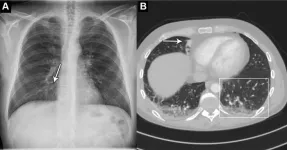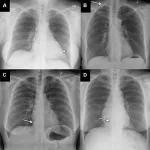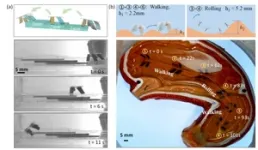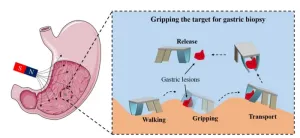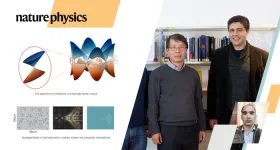(Press-News.org) OAK BROOK, Ill. – An artificial intelligence (AI) tool can accurately identify normal and abnormal chest X-rays in a clinical setting, according to a study published in Radiology, a journal of the Radiological Society of North America (RSNA).
Chest X-rays are used to diagnose a wide variety of conditions to do with the heart and lungs. An abnormal chest X-ray can be an indication of a range of conditions, including cancer and chronic lung diseases.
An AI tool that can accurately differentiate between normal and abnormal chest X-rays would greatly alleviate the heavy workload experienced by radiologists globally.
“There is an exponentially growing demand for medical imaging, especially cross-sectional such as CT and MRI,” said study co-author Louis Lind Plesner, M.D., from the Department of Radiology at the Herlev and Gentofte Hospital in Copenhagen, Denmark. “Meanwhile, there is a global shortage of trained radiologists. Artificial intelligence has shown great promise but should always be thoroughly tested before any implementation.”
For this retrospective, multi-center study, Dr. Plesner and colleagues wanted to determine the reliability of using an AI tool that can identify normal and abnormal chest X-rays.
Researchers used a commercially available AI tool to analyze the chest X-rays of 1,529 patients from four hospitals in the capital region of Denmark. Chest X-rays were included from emergency department patients, in-hospital patients and outpatients. The X-rays were classified by the AI tool as either “high-confidence normal” or “not high-confidence normal” as in normal and abnormal, respectively.
Two board-certified thoracic (chest) radiologists were used as the reference standard. A third radiologist was used in cases of disagreements, and all three physicians were blinded to the AI results.
Of the 429 chest X-rays that were classified as normal, 120, or 28%, were also classified by the AI tool as normal. These X-rays, or 7.8 % of all the X-rays, could be potentially safely automated by an AI tool. The AI tool identified abnormal chest X-rays with a 99.1% of sensitivity.
“The most surprising finding was just how sensitive this AI tool was for all kinds of chest disease,” Dr. Plesner said. “In fact, we could not find a single chest X-ray in our database where the algorithm made a major mistake. Furthermore, the AI tool had a sensitivity overall better than the clinical board-certified radiologists.”
According to the researchers, further studies could be directed toward larger prospective implementation of the AI tool where the autonomously reported chest X-rays are still reviewed by radiologists.
The AI tool performed especially well at identifying normal X-rays of the outpatient group at a rate of 11.6%. This suggests that the AI model would perform especially well in outpatient settings with a high prevalence of normal chest X-rays.
“Chest X-rays are one of the most common imaging examination performed worldwide,” Dr. Plesner said. “Even a small percentage of automatization can lead to saved time for radiologists, which they can prioritize on more complex matters.”
###
“Autonomous Chest Radiograph Reporting Using AI: Estimation of Clinical Impact.” Collaborating with Dr. Plesner were Felix C. Müller, M.D., Ph.D., Janus D. Nybing, M.Sc., Lene C. Laustrup, M.D., Finn Rasmussen, M.D., D.M.Sc., Olav W. Nielsen, M.D., Ph.D., Mikael Boesen, M.D., Ph.D., and Michael B. Andersen, M.D., Ph.D.
In 2023, Radiology is celebrating its 100th anniversary with 12 centennial issues, highlighting Radiology’s legacy of publishing exceptional and practical science to improve patient care.
Radiology is edited by Linda Moy, M.D., New York University, New York, N.Y., and owned and published by the Radiological Society of North America, Inc. (https://pubs.rsna.org/journal/radiology)
RSNA is an association of radiologists, radiation oncologists, medical physicists and related scientists promoting excellence in patient care and health care delivery through education, research, and technologic innovation. The Society is based in Oak Brook, Illinois. (RSNA.org)
For patient-friendly information on chest X-ray, visit RadiologyInfo.org.
END
A study at Hospital for Special Surgery (HSS) found that intraoperative three-dimensional (3D) imaging was superior to two-dimensional radiographs in confirming the accuracy of pedicle screw placement during spine surgery. The research was presented today at the American Academy of Orthopaedic Surgeons (AAOS) Annual Meeting in Las Vegas.
Many spinal surgeries require the use of implants called pedicle screws to stabilize the spine. Precise positioning of these screws is critical for a successful outcome. “Two-dimensional biplanar radiographs [BPR] ...
Recently, a research team from Shenzhen Institute of Advanced Technology, Chinese Academy of Sciences, proposed a bionic quadruped soft thin-film microrobot actuated by magnetic fields with a mass of only 41 mg, which promises to be applied to stomach examination and treatment. Researchers realized the multimodal locomotion control of the soft microrobot in magnetic fields and the grasping and transportation of micro-objects by the soft microrobot.
The new paper, published in Cyborg and Bionic System, details the process ...
Starting with the emergence of quantum mechanics, the world of physics has been divided between classical and quantum physics. Classical physics deals with the motions of objects we typically see every day in the macroscopic world, while quantum physics explains the exotic behaviors of elementary particles in the microscopic world.
Many solids or liquids are composed of particles interacting with one another at close distances, which sometimes results in the rise of “quasiparticles.” Quasiparticles are long-lived excitations that behave effectively as weakly interacting particles. The idea of quasiparticles was introduced by the Soviet physicist Lev Landau in 1941, and ...
Network-assisted full-duplex (NAFD) systems enable uplink and downlink communications within the same time-frequency resources, so as to avoid the overhead of switching uplink/downlink modes. However, as the number of users and access points (APs) proliferated, mass access brings significant overhead in mode selection. In addition, the differentiated service demands among users also makes the effective utilization of resources difficult. Combined with network slicing technology, a slicing capacity-centered mode selection and resource optimization scheme is proposed. This scheme adopts a double-layer deep reinforcement ...
“As a Black woman, I’m invisible. They just erase your humanity. You don’t exist in front of them.” (Tessa, 33-year-old Black research assistant)
“It wasn’t about disliking what I did or being judgmental of what I did. It was a different kind of problem, to not be acknowledged. They didn’t care. There was no curiosity. They didn’t give a f***. We were invisible.” (Brinda, 30-year-old South Asian consultant)
Invisibility is a salient and recurring experience of mistreatment for women of colour working in traditionally white and male professions, two ...
Love muffins? We’re talking about a tasty, fluffy muffin that has no artificial additives and that simultaneously contains lots of beneficial nutrients. As remarkable as it might sound, a recently published study led describes the development of just such a new muffin in the journal Foods.
From muffins to functional food
The new super muffin has been named Roselle, because it contains calyx extract from the tropical plant Hibiscus sabdariffa, which is often referred to by the same name.
[caption id="attachment_79738" align="aligncenter" width="559"] Here's a look at the different formulations that researchers tested. Photo: Screenshot from Food ...
Will AI drive the next biomedical revolution? Why is RNA so powerful? What can we learn from studying bias? You’ll get the answers to these questions and more at Discover BMB, the annual meeting of the American Society for Biochemistry and Molecular Biology, to be held March 25–28 in Seattle.
Reporters are invited to register for a complimentary press pass to attend #DiscoverBMB in Seattle or to access press materials electronically.
This year’s #DiscoverBMB program features leading ...
Color plays a huge role in our lives — the hues we wear and decorate with are a way for us to signal who we are, where we’re from, and what we care about. And it’s been that way for a long time. In a new study in the Journal of Archaeological Science: Reports, archaeologists compared the colors on pieces of ancient Peruvian pottery. They found that potters across the Wari empire all used the same rich black pigment to make ceramics used in rituals: a sign of the empire’s influence.
The Wari empire spread over Peru’s highlands and coastal areas from 600-1050 ...
According to NOAA Fisheries, more than 80 percent of marine aquaculture production in the United States consists of bivalve mollusks such as oysters, clams and mussels. However, it’s not just humans who enjoy eating these shellfish, so do marine rays. They like to “crunch” on clams, which can sometimes take a big bite out of clammers’ profits.
Part of the process of culturing hard clams (Mercenaria mercenaria) involves deploying them in submerged bottom leases in the marine environment where clams can grow to market size. When deployed onto the clam lease, clammers incorporate a variety of anti-predator ...
AMES, IA — With the youngest baby boomers sliding into retirement, adults aged 65 and older are expected to outnumber children by 2030. The demographic shift will be a first in U.S. history. But many rural areas, especially in the Midwest and Great Plains, are already experiencing this.
Researchers are looking to small towns in Iowa to understand how some support aging in place better than others. Their findings, published in Journal of Rural Studies, could help communities plan for the ...
